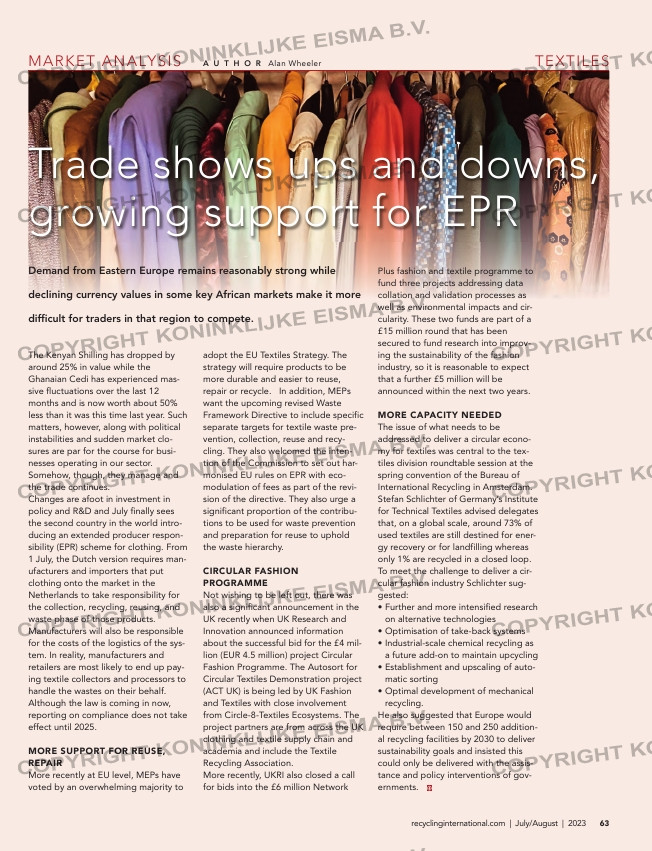Page 63 from: Recycling International – July/August issue 2023

TEXTILESMARKET ANALYSIS
Trade shows ups and downs,
growing support for EPR
Demand from Eastern Europe remains reasonably strong while
declining currency values in some key African markets make it more
difficult for traders in that region to compete.
63recyclinginternational.com | July/August | 2023
The Kenyan Shilling has dropped by
around 25% in value while the
Ghanaian Cedi has experienced mas-
sive fluctuations over the last 12
months and is now worth about 50%
less than it was this time last year. Such
matters, however, along with political
instabilities and sudden market clo-
sures are par for the course for busi-
nesses operating in our sector.
Somehow, though, they manage and
the trade continues.
Changes are afoot in investment in
policy and R&D and July finally sees
the second country in the world intro-
ducing an extended producer respon-
sibility (EPR) scheme for clothing. From
1 July, the Dutch version requires man-
ufacturers and importers that put
clothing onto the market in the
Netherlands to take responsibility for
the collection, recycling, reusing, and
waste phase of those products.
Manufacturers will also be responsible
for the costs of the logistics of the sys-
tem. In reality, manufacturers and
retailers are most likely to end up pay-
ing textile collectors and processors to
handle the wastes on their behalf.
Although the law is coming in now,
reporting on compliance does not take
effect until 2025.
MORE SUPPORT FOR REUSE,
REPAIR
More recently at EU level, MEPs have
voted by an overwhelming majority to
adopt the EU Textiles Strategy. The
strategy will require products to be
more durable and easier to reuse,
repair or recycle. In addition, MEPs
want the upcoming revised Waste
Framework Directive to include specific
separate targets for textile waste pre-
vention, collection, reuse and recy-
cling. They also welcomed the inten-
tion of the Commission to set out har-
monised EU rules on EPR with eco-
modulation of fees as part of the revi-
sion of the directive. They also urge a
significant proportion of the contribu-
tions to be used for waste prevention
and preparation for reuse to uphold
the waste hierarchy.
CIRCULAR FASHION
PROGRAMME
Not wishing to be left out, there was
also a significant announcement in the
UK recently when UK Research and
Innovation announced information
about the successful bid for the £4 mil-
lion (EUR 4.5 million) project Circular
Fashion Programme. The Autosort for
Circular Textiles Demonstration project
(ACT UK) is being led by UK Fashion
and Textiles with close involvement
from Circle-8-Textiles Ecosystems. The
project partners are from across the UK
clothing and textile supply chain and
academia and include the Textile
Recycling Association.
More recently, UKRI also closed a call
for bids into the £6 million Network
Plus fashion and textile programme to
fund three projects addressing data
collation and validation processes as
well as environmental impacts and cir-
cularity. These two funds are part of a
£15 million round that has been
secured to fund research into improv-
ing the sustainability of the fashion
industry, so it is reasonable to expect
that a further £5 million will be
announced within the next two years.
MORE CAPACITY NEEDED
The issue of what needs to be
addressed to deliver a circular econo-
my for textiles was central to the tex-
tiles division roundtable session at the
spring convention of the Bureau of
International Recycling in Amsterdam.
Stefan Schlichter of Germany’s Institute
for Technical Textiles advised delegates
that, on a global scale, around 73% of
used textiles are still destined for ener-
gy recovery or for landfilling whereas
only 1% are recycled in a closed loop.
To meet the challenge to deliver a cir-
cular fashion industry Schlichter sug-
gested:
• Further and more intensified research
on alternative technologies
• Optimisation of take-back systems
• Industrial-scale chemical recycling as
a future add-on to maintain upcycling
• Establishment and upscaling of auto-
matic sorting
• Optimal development of mechanical
recycling.
He also suggested that Europe would
require between 150 and 250 addition-
al recycling facilities by 2030 to deliver
sustainability goals and insisted this
could only be delivered with the assis-
tance and policy interventions of gov-
ernments.
A U T H O R Alan Wheeler
63_matextiles.indd 63 05-07-2023 12:06



